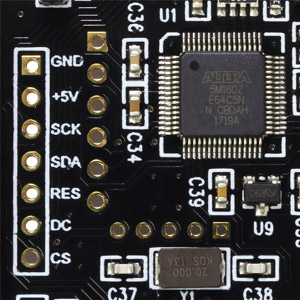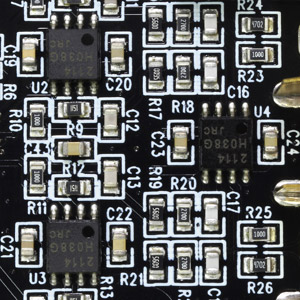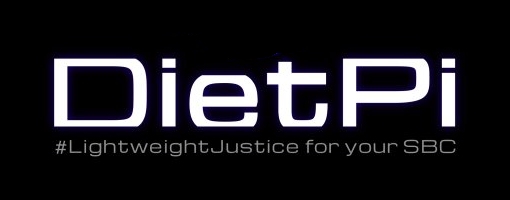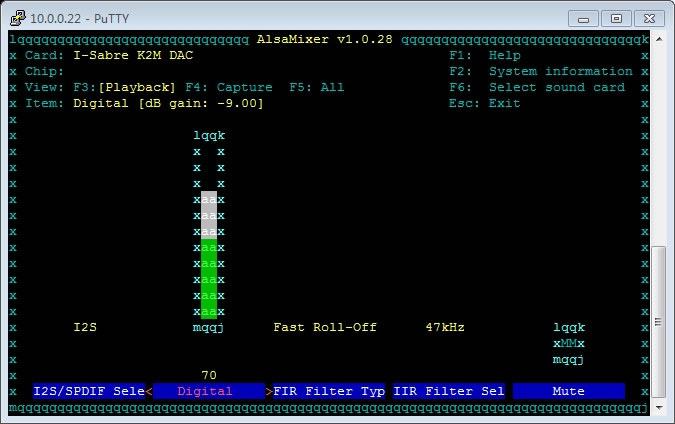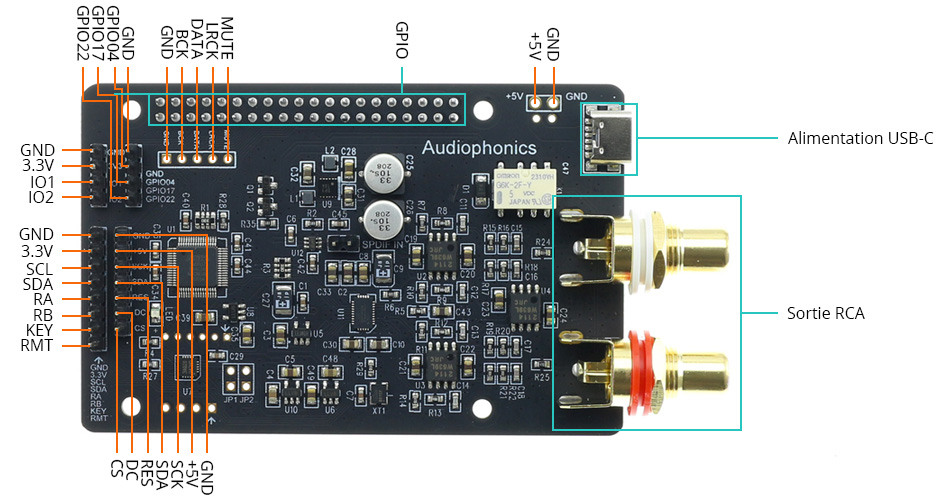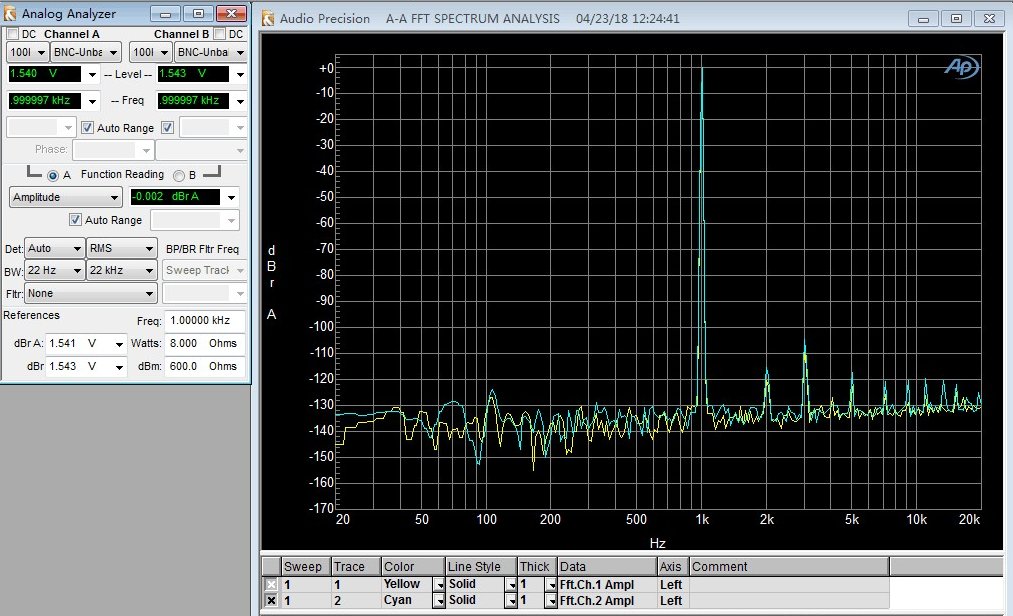Audiophonics offers you the successor of the DAC I-Sabre 9028 boarding this time the decoding chip ES9038Q2M. This version offers remarkable sound performance, thanks to the Hyperstream II architecture, traditionally reserved for professional devices.
Ever increasing audio quality
Following its predecessors, the ES9038Q2M offers exceptional sound performance thanks to components selected to ensure the greatest accuracy and precision in the restitution without sounding aggressive.
This version is based on recognized technologies. It also benefits from Hyperstream II, significantly improving dynamic range while reducing jitter and unwanted noise.
The design includes an ultra low phase noise crystal as clock for ES9038Q2M.
An autonomous system
Like the previous ES9028Q2M, the ES9038Q2M has been designed to mount on a Raspberry Pi, thus providing the best possible output quality for a compact player.
It is compatible with other GPIO Raspberry format cards as well. Moreover it is possible to connect it to any I2S or SPDIF source. (USB interface, DSP ..)
The card offers an encoder-controlled hardware volume control, with an OLED screen display, allowing it to operate in complete autonomy.
Specific driver installation is optional and will allows you to control the volume or change the input source from Linux.
An improved user experience
Thanks to a built-in microprocessor, the I-Sabre 9038Q2M is able to automatically detect the format and sampling rate of the source and automatically adapt to it.
It automatically detects if the source is 16bit / 24bit or DSD DOP
This CPLD chip control maintains high stability while preventing decoding problems as well as the appearance of listening artifacts.
A complete solution
This converter has the potential to evolve into a complete solution. By way of example, an OLED screen dedicated to displaying the source, the volume and the bitrate can easily be added.
We can also add an encoder to control the volume of the DAC to avoid loss of quality inherent software volume management.
Warning: This product contains only the Audiophonics I-Sabre ES9038Q2M DAC. The RaspBerry Pi, OLED screen and rotary encoder are sold separately.
The rotary encoder only works if the OLED display is also present.
Built-in dedicated kernel kernel driver in RPI > 4.19.34
Used in conjunction with a Raspberry Pi, the I-DAC Sabre ES9038Q2M benefits from a complete dematerialized streaming solution.
Audiophonics 9038Q2M driver is supported by Raspberry Pi kernel since version 4.19.34, which greatly facilitates the installation, and provides instant access to the hardware volume control, filter management, and input selection (I2S / SPDIF) .
(Dtoverlay = i-sabre-Q2M in config.txt)
To date (June 2019) the selection of the driver is built in:
Controling DAC functions with I2C
This DAC card has a micro-controller which is very helpful to set basic functions. Any user can control it with an Arduino or any I2C controler for in housing integration.
The card allows multiple control thanks to 4 possible I2C addresses that can be reached with jumpers JP1 & JP2 :
I2C Address
- Without jumper : 0x48
- JP1 : 0x49
- JP2 : 0x4A
- JP1 & JP2 : 0x4B
Once connected the following registers are accessible (read-only) :
Registers functions
- 0x20 : Volume from 0 to 100
- 0x21 : Mute 0x00 = Mute OFF, 0x01 = Mute ON
- 0x22 : Filters :
- 0x00 = brick wall
- 0x01 = corrected minimum phase fast
- 0x02 = minimum phase slow
- 0x03 = minimum phase fast
- 0x04 = linear phase slow
- 0x05 = linear phase fast
- 0x06 = apodizing fast
- 0x21 : Mute 0x00 = Mute OFF, 0x01 = Mute ON
- 0x24 : Entrée 0x00 = I2S, 0x01 = SPDIF
Excerpt of Arduino code for volume control
Adresse_I2C = 0x48;
VarVolume = 50;
Wire.beginTransmission(Adresse_I2C);
Wire.write(0x20);
Wire.write(VarVolume);
Wire.endTransmission();
Supported PCM / DSD formats
The DAC-ISABRE is 24/192 compatible with the RPI-DAC driver and up to 32bit 384KHZ with its driver and distributions using an optimized audio kernel. (Volumio, Dietpi ...)
It can also read DSD64 / DSD128 DOP with solutions like Volumio and Logitech Media Server
SPDIF input accepts PCM format up to 24/192 and DSD 128 DOP.
I2S Input can accept up to PCM 32/768k and DSD 512 DOP. The use in addition to an Allo KALI is not compatible with the DSD mode.
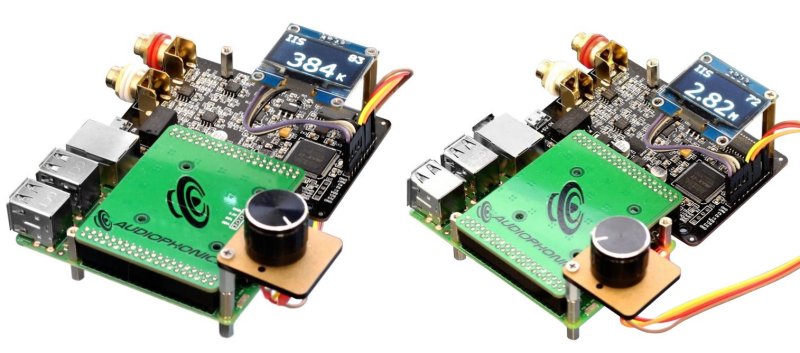 Pictures may show an old version of the board. Do not use them as a reference for your installation
Pictures may show an old version of the board. Do not use them as a reference for your installation 

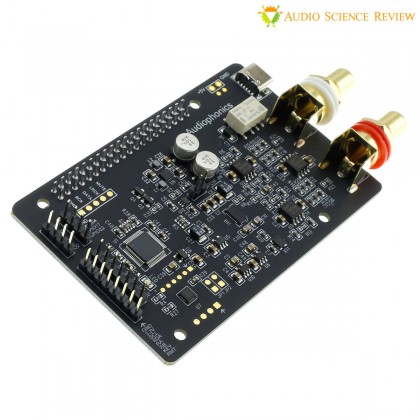










![[GRADE S] FIIO KA2 LIGHTNING Portable DAC Headphone Amplifier 2x CS43131 32bit 384kHz DSD256](https://www.audiophonics.fr/61299-thumb_default/fiio-ka2-lightning-portable-dac-headphone-amplifier-2x-cs43131-32bit-384khz-dsd256.jpg)
![[GRADE S] TOPPING DX7 PRO Balanced DAC Headphone Amplifier ES9038Pro Bluetooth 5.0 aptX HD LDAC 32bit 768kHz DSD1024 Black](https://www.audiophonics.fr/47119-thumb_default/-grade-s-topping-dx7-pro-balanced-dac-headphone-amplifier-es9038pro-bluetooth-50-aptx-hd-ldac-32bit-768khz-dsd1024-black.jpg)
![[GRADE S] GUSTARD C18 Master Clock OCXO 10MHz Silver](https://www.audiophonics.fr/67112-thumb_default/gustard-c18-master-clock-ocxo-10mhz-silver-stockb.jpg)
![[GRADE B] DAYTON AUDIO SD270A-88 Speaker Driver Subwoofer DVC 80W 4 Ohm 88dB 26Hz-2000Hz Ø25.4cm](https://www.audiophonics.fr/67029-thumb_default/dayton-audio-sd215a-88.jpg)
























